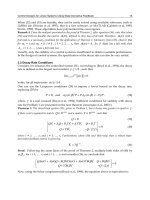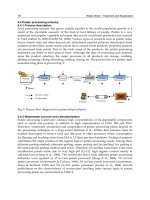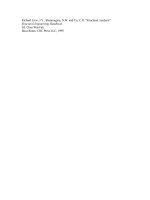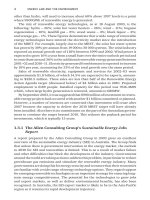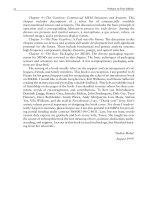Volume 01 - Properties and Selection Irons, Steels, and High-Performance Alloys Part 2 pptx
Bạn đang xem bản rút gọn của tài liệu. Xem và tải ngay bản đầy đủ của tài liệu tại đây (5.23 MB, 160 trang )
Fig. 8
Effect of carbon equivalent on the tensile strength of flake, compacted, and spheroidal graphite irons
cast into 30 mm (1.2 in.) diam bars. Source: Ref 10
Although increasing the silicon content decreases the pearlite to ferrite ratio in the as-cast state, both the
strength and hardness of as-cast and annealed CG irons improve. This is because of the hardening of ferrite by
silicon. For the same reasons, elongation in the annealed condition decreases, but increases for the as-cast state
(Ref 10). Although increasing the phosphorus content slightly improves strength, a maximum of 0.04% P is
desirable to avoid lower ductility and impact strength.
The pearlite/ferrite ratio, and thus the strength and hardness of CG irons, can be increased by the use of a
number of alloying elements such as copper, nickel, molybdenum, tin, manganese, arsenic, vanadium, and
aluminum (Ref 6, 14). The effect of copper and molybdenum on the tensile properties of CG irons is shown in
Fig. 9. After annealing to a fully ferritic structure, it is possible to increase the yield point of CG iron by 24%
when using 1.5% Ni (Table 3). This is because of the strengthening of the solid solution by nickel (Ref 6). The
reader is cautioned, however, that additions of copper, nickel, and molybdenum may increase nodularity (Ref
6).
Table 3 Effect of heat treatment and alloying with nickel on the tensile properties of CG iron measured on a
25 mm section size
Tensile strength
Yield strength
Heat treatment
Iron Matrix
(a)
MPa ksi MPa ksi
Elongation,
%
Hardness,
HB
Nickel,
%
As-cast 60% F 325 47.1 263 38.1 2.8 153
0
Annealed
(b)
100% F 294 42.6 231 33.5 5.5 121
0
Normalized
(c)
90% P 423 61.3 307 44.5 2.5 207
0
As-cast . . . 427 61.9 328 47.6 2.5 196
1.53
Annealed
(b)
100% F 333 48.3 287 41.6 6.0 137
1.53
Normalized
(c)
90% P 503 73 375 54.4 2.0 235 1.53
(a)
F, ferrite; P, pearlite.
(b)
Annealed, 2 h at 900 °C (1650 °F), cooled in furnace to 690 °C (1275 °F), held 12 h, cooled in air.
(c)
Normalized, 2 h at 900 °C (1650 °F), cooled in air
Fig. 9 Effect of (a) copper and (b) molybdenum on the tensile properties of CG iron. Source: Ref 13, 14
In order to compare the quality of different types of irons, several quality indexes can be used, such as the
product of tensile strength and elongation (TS × El) or the ratio of tensile strength to Brinell hardness (TS/HB).
Higher values of these indexes will characterize a better iron. Using the data given in Ref 10, some typical
values were calculated for these indexes for unalloyed CG irons. Figure 10 compares the TS × El product and
the TS/HB ratio for unalloyed and aluminum-alloyed CG irons. It can be seen that when 2% Si is replaced by
2% Al, a much better quality CG iron is produced (Ref 11).
Fig. 10 Quality indexes for Fe-C-Si and Fe-C-Al irons. TS, tensile strength; El, elongation. Source: Ref 11
Effect of Structure. One of the most important variables influencing the tensile properties of CG irons is
nodularity. As nodularity increases, higher strength and elongation are to be expected, as shown in Table 4 and
Fig. 11, although nodularity must be maintained at levels under 20% for the iron to qualify as CG iron.
However, spheroidal graphite contents of up to 30% and even more must be expected in th in sections of
castings with considerable variation in wall thickness.
Table 4 Properties of CG iron as a function of nodularity
Tensile strength
Nodularity, %
MPa ksi
Elongation, %
Thermal conductivity,
W/(m · K)
Shrinkage, %
10-20 320-380
46-55
2-5 50-52
1.8-2.2
20-30 380-450
55-65
2-6 48-50
2.0-2.6
40-50 450-500
65-73
3-6 38-42 3.2-4.6
Fig. 11 Correlation between nodularity and elongation for ferritic CG iron. Source: Ref 16
As previously discussed, the pearlite/ferrite ratio can be increased by causing alloying elements. Another way
of increasing or decreasing this ratio is by using heat treatment. The influence of heat treatment on mechanical
properties of CG irons with 20% nodularity is given in Table 3.
Effect of Section Size. Like all other irons, CG irons are rather sensitive to the influence of cooling rate, that
is, to section size, because it affects both the pearlite/ferrite ratio and graphite morphology. As mentioned
before, a higher cooling rate promotes more pearlite and increased nodularity. A typical example of the
influence of section size on the microstructure of CG iron is provided in Fig. 12. Although CG iron is less
section sensitive than FG iron (as shown in Fig. 13 for tensile strength), the influence of cooling rate may be
quite significant (see the article "Compacted Graphite Irons" in Casting, Volume 15 of ASM Handbook,
formerly 9th Edition Metals Handbook). When the section size decreases until it is below 10 mm (0.4 in.), the
tendency to increased nodularity and for higher chilling must be considered. This is particularly true for
overtreated irons. While it is possible to eliminate the carbides that result from chilling by heat treatment, it is
impossible to change the graphite shape, which remains spheroidal, with the associated consequences. Other
factors influencing the cooling of castings, such as shakeout temperature, can also influence properties.
Fig. 12
Influence of section size on the microstructure of CG iron produced by inmold. Samples from series
E3.3. (a) 3.2 mm (0.125 in.). (b) 6.4 mm (0.250 in.).
(c) 12.7 mm (0.500 in.). (d) 25.4 mm (1.000 in.).(e)
50.8 mm (2.000 in.). 100×
Fig. 13 Influence of section size on the tensile strength of CG iron. Source: Ref 15
Compressive Properties. The stress-strain diagram for compression and tensile tests of CG iron is shown in
Fig. 14. It can be seen that an elastic behavior occurs up to a compression stress of 200 MPa (30 ksi). Some
compressive properties of the 179 HB as-cast ferritic CG iron in Table 2 are compared with those of SG iron in
Table 5. It can be seen that the 0.1% proof stress in compression for CG iron is 76 MPa (11 ksi) higher than the
0.1% proof stress in tension, while for SG iron the difference is only 23 MPa (3.3 ksi). Compressive strengths
up to 1400 MPa (203 ksi) have been reported for ferritic annealed CG irons (Ref. 8).
Table 5 Comparison of tensile and compressive properties of CG and SG irons
Property CG iron
SG iron
Tensile strength, MPa (ksi) 380 (55) 370 (54)
420 (61)
0.1% proof stress, MPa (ksi) 246 (35.7)
224 (32.5)
261 (37.8)
0.2% proof stress, MPa (ksi) 242 (35.1)
236 (34.2)
273 (39.6)
Compressive stress
0.1% proof stress, MPa (ksi)
322 (46.7)
247 (35.8)
284 (41.2)
0.2% proof stress, MPa (ksi)
350 (50) 250 (36.3)
287 (41.6)
Source: Ref 6
Fig. 14 Stress-strain curves in compression and tension for CG iron with 4.35 carbon equivalent. Source: Ref 9
Shear Properties. For a pearlitic CG iron, the shear strength on 20 mm (0.8 in.) diam specimens was
measured at 365 MPa (53 ksi), with a shear-to-tensile strength ratio of 0.97 (Ref 17). Ratios of 0.90 for SG iron
and of 1.1 to 1.2 for FG iron have been reported. Materials exhibiting some ductility have ratios lower than 1.0
(Ref 8).
Modulus of Elasticity. As is evident from Fig. 5 and 14, CG irons exhibit a clear zone of proportionality, both
in tension and in compression. Typical values for both static and dynamic (resonance frequency method)
measurements are given in Table 2. Dynamic tests give slightly higher numbers. In general, the moduli of
elasticity for CG iron are similar to those of high-strength FG irons and can even be higher as nodularity
increases.
The elasticity modulus measured by the tangent method depends on the level of stress, as shown in Fig. 15. A
comparison of the stress dependency of the elasticity modulus for different types of cast irons is shown in Fig.
16. Poisson's ratios of 0.27 to 0.28 have been reported for CG irons (Ref 8).
Fig. 15 Stress dependency by E-modulus for two heat-treated CG irons. Source: Ref 6
Fig. 16 Influence of stress level on the elasticity modulus (a) in tension and (b) in compression fo
r pearlitic FG,
CG, and SG irons. Source: Ref 6
Impact Properties. While SG iron exhibits substantially greater toughness at low pearlite contents, pearlitic
CG irons have impact strengths equivalent to those of SG irons (Fig. 17). Charpy impact energy measurements
at 21 °C (70 °F) and -41 °C (-42 °F) showed that CG irons produced from an SG-base iron absorbed greater
energy than those made from gray iron-base iron (Ref 10). This is attributed to the solute hardening effects of
tramp elements in the gray iron.
Fig. 17 Effect of pearlite content on the 21 °C (70 °F) Charpy V-notch impact strength of as-
cast CG irons
compared to that of SG iron. Source: Ref 10
The results from dynamic tear tests were similar, although greater temperature dependence was observed. A
comparison of the dynamic tear energies of CG cast irons is presented in Fig. 18. It is noted that significant
differences in the values obtained occur in the ferritic condition, but that equivalent values are obtained when
the matrix structure is primarily pearlitic.
Fig. 18 Dynamic tear energy versus temperature for (a) CG and (b) SG irons. Source: Ref 10
Studies on crack initiation and growth under impact loading conditions showed that, in general, the initiation of
matrix cracking was preceded by graphite fracture at the graphite-matrix interface, or through the graphite, or
both. The most dominant form of graphite fracture appeared to be that occurring along the boundaries between
graphite crystallites (Ref 18). Matrix cracks were usually initiated in the ferrite by transgranular cleavage
(graphite was nearly always surrounded by ferrite), although in some instances intergranular ferrite fracture
appeared to be the initiating mechanism. Matrix crack propagation generally occurred by a brittle cleavage
mechanism, transgranular in ferrite, and interlamellar in pearlite. In general, the impact resistance of CG irons
increases with carbon equivalent and decreases with phosphorous or increasing pearlite.
As may be seen in Table 6, cerium-treated CG irons seem to exhibit a higher impact energy than magnesium-
titanium-treated irons. It is thought that this may be attributed to TiC and TiCN inclusions present in the matrix
of magnesium-titanium-treated CG irons (Ref 6).
Table 6 Impact toughness of a cerium-treated CG cast iron and two magnesium-titanium-treated CG cast
irons
Test
temperature
Impact bend
toughness
(a)
Notched-
bar
(b)
impact
toughness
Iron Structural condition and
graphite type
°C °F J ft ·
lbf
J
ft ·
lbf
20 68 32.1 23.7 6.5
4.8
-20 -4 26.5 19.5 4.6
3.4
Cerium-treated (150 HB iron in Table 2 ) >95% ferrite (as-cast); 95% CG,
5% SG
-40 -40 26.7 19.7 5.0
3.7
Magnesium (0.018%) and titanium (0.089%)
treated
100% ferrite (annealed); CG 20 68 13.5-19
10-14
5.4
4.0
Magnesium (0.017% and titanium (0.062%)
treated
Ferritic (as-cast); CG 20 68 6.8-
10.2
5-7.5 3.4
2.5
(a)
Unnotched 10 × 10 mm (Charpy) testpiece.
(b)
V-notched 10 × 10 mm (Charpy) testpiece.
Fatigue Strength. Because the notching effect of graphite in CG iron is considerably lower than that in FG
irons, it is expected that CG iron will have higher fatigue strengths than FG iron (Table 1). Table 7 lists the
fatigue strengths of five CG irons from Table 2. The as-cast ferritic (>95% ferrite) CG with a hardness of 150
HB had the highest fatigue strength and the highest fatigue-endurance ratio (fatigue strength/tensile strength).
Fatigue properties for three of these CG irons with comparable endurance ratios are shown in Fig. 19. It is
evident that pearlitic structures, higher nodularity, and unnotched samples resulted in better fatigue strength.
The fatigue-endurance ratio was 0.46 for a ferritic matrix, 0.45 for a pearlitic matrix, and 0.44 for a pearlitic
higher-nodularity CG iron (Ref 17). With fatigue notch factors (ratio of unnotched to notched fatigue strength)
of 1.71 to 1.79, CG iron is almost as notch sensitive as SG iron (>1.85). Gray iron is considerably less notch
sensitive, with a notch factor of less than 1.5 (Ref 6).
Table 7 Fatigue strengths and endurance ratios for five CG irons from rotating bending tests
Matrix structure Graphite type
Tensile
strength
Fatigue
strength
Fatigue-
endurance
ratio
Hardness,
HB
MPa
ksi MPa
ksi
ratio
As-cast ferrite (>95% ferrite) 95% CG 336 48.7
211 30.6
0.63
150
As-cast ferrite CG 388 56.3
178 25.8
0.46
184
As-cast pearlite CG 414 60 185 26.8
0.45
205
As-cast pearlite CG + SG 473 68.6
208 30.2
0.44
217
As-cast pearlite (70% pearlite)
CG 386 56.0
186 27 0.48 . . .
Source: Ref 6
Fig. 19 Fatigue curves in rotating bending tests for ferritic, pearlitic, and higher nodularity CG irons from
Table
7. Source: Ref 17
Statistical analysis of a number of experimental data allowed the calculation of a relationship between fatigue
strength (FS) and tensile strength (TS) of CG irons (Ref 6):
FS (in MPa) = (0.63 -
0.00041 · TS)
·TS (in MPa)
(Eq 1)
Values calculated with this equation fit well between those of FG and SG irons. The intermediate position of
CG irons from this standpoint is also shown in Fig. 20.
Fig. 20 Ratio of alternating bend fatigue strength/tensile strength of FG, CG, and SG irons. Source: Ref 6
A 36% decrease of the alternating bending fatigue strength was observed on unnotched bars with casting skin
compared to machined bars. This compares with a 50% reduction for comparable strength FG iron and a 32%
reduction for ferritic SG iron.
References cited in this section
1. E. Nechtelberger, H. Puhr, J.B. von Nes
selrode, and A. Nakayasu, Paper 1 presented at the 49th
International Foundry Congress, International Committee of Foundry Technical Associations, Chicago,
1982
6. E. Nechtelberger, The Properties of Cast Iron up to 500 °C, Technicopy Ltd., 1980
7. J. Sissener, W. Thury, R. Hummer, and E. Nechtelberger, AFS Cast Met. Res. J., 1972, p 178
8. C.F. Walton and T.J. Opar, Ed., Iron Castings Handbook, Iron Casting Society Inc., 1981
9. G.F. Sergeant and E.R. Evans, The British Foundryman, May 1978, p 115
10.
K.P. Cooper and C.R. Loper, Jr., Trans. AFS, Vol 86, 1978, p 241
11.
F. Martinez and D.M. Stefanescu, Trans. AFS, Vol 91, 1983, p 593
13.
J. Fowler, D.M. Stefanescu, and T. Prucha, Trans. AFS, Vol 92, 1984, p 361
14.
R.B. Gundlach, Trans. AFS, Vol 86, 1978, p 551
15.
Spravotchnik po Tchugunomu Ljitiu (Cast Iron Handbook), 3rd ed., Mashinostrojenie, 1978
16.
K.H. Riemer, Giesserei, Vol 63 (No. 10), 1976, p 285
17.
K.B. Palmer, BCIRA J., Report 1213, Jan 1976, p 31
18.
A.F. Heiber, Trans. AFS, Vol 87, 1979, p 569
Compacted Graphite Iron
Doru M. Stefanescu, The University of Alabama
Elevated-Temperature Properties
Tensile Properties. The variation of tensile properties with temperature for CG iron produced with cerium-
mischmetal treatment alloys is similar to that typical for SG iron (Fig. 21), but the values are somewhat lower
(Ref 19). Similar results are reported for CG irons produced with Mg-Ti-ferrosilicon alloys shown in Fig. 22.
As expected, a slight increase in nodularity led to higher tensile strength values at all temperatures.
Fig. 21 Variation of tensile properties of Ce-treated CG and SG irons with temperature. Source: Ref 19
Fig. 22 Variation of tensile properties of Mg+Ti-treated CG irons. Source: Ref 20
Growth and Scaling. Tests conducted for 32 weeks in air have shown that at 500 °C (930 °F) the growth and
scaling of CG iron was not significantly different from that exhibited by FG irons of similar composition.
However, at 600 °C (1110 °F), the growth of CG irons was less than that of FG iron, and scaling resistance was
superior (Fig. 23).
Fig. 23
Scaling and growth of heavy section flake and compacted graphite cast irons at 600 °C (1110 °F).
Source: Ref 9
In other oxidation studies of cast irons conducted at 600 °C (1110 °F), it was concluded that weight gains due to
oxidation are 10 to 15% higher for CG irons than for SG irons, but 30 to 60% lower for CG irons than for FG
irons (Ref 21).
Thermal Fatigue. When castings are used in an environment where frequent changes in temperature occur, or
where temperature differences are imposed on a part, thermal stresses occur in castings and may result in elastic
and plastic strains and finally in crack formation. The casting can thus be destroyed as a result of thermal
fatigue. Changes in microstructure, associated with stress-including volume changes, as well as surface and
internal oxidation, may also be associated with temperature difference induced stresses.
The interpretation of thermal fatigue tests is complicated by the many different test methods employed by
various investigators. The two widely accepted methods are constrained thermal fatigue and finned-disk
thermal shock tests (Ref 22, 23).
In the constrained thermal fatigue test, a specimen (see Fig. 24 (a) for dimensions) is mounted between two
stationary plates that are held rigid by two columns, heated by high frequency (450 kHz) induction current, and
cooled by conduction of heat to water-cooled grips (Fig. 24(b)). The thermal stress that develops in the test
specimen is monitored by a load cell installed in one of the grips holding the specimen. During thermal cycling,
compressive stresses develop upon heating, and tensile stresses develop upon cooling. As thermal cycling
continues, the specimen accumulates fatigue damage in a fashion similar to that in mechanical fatigue testing;
ultimately, the specimen fails by fatigue. Initially the specimen develops compressive stress upon heating due
to constrained thermal expansion (Fig. 25). Some yielding and stress relaxation occur during holding at 540 °C
(1000 °F), and upon subsequent cooling the specimen develops residual tensile stress. During subsequent
thermal cycling, the maximum compressive stress that has developed upon heating decreases continuously, and
the maximum tensile stress upon cooling increases, as shown for six different irons in Fig. 26.
Fig. 24 (a) Dimensions of constrained fatig
ue test specimen. (b) Schematic of apparatus for constrained
fatigue tests. Dimensions given in millimeters. Source: Ref 23
Fig. 25 Typical thermal stress cycles at the beginning of the test for FG and CG irons. Source: Ref 23
Fig. 26
The shift in thermal stress versus the number of cycles for six irons cycled between 100 and 540 °C
(212 and 1000 °F). Source: Ref 23
Experimental results (Fig. 27) point to higher thermal fatigue for CG iron than for FG iron and also indicate the
beneficial effect of molybdenum. In fact, regression analysis of experimental results indicates that the main
factors influencing thermal fatigue are tensile strength (TS) and molybdenum content:
log N = 0.934 + 0.026 · TS + 0.861 · Mo
(Eq 2)
where N is the number of thermal cycles to failure, tensile strength is in kps per square inch (ksi), and
molybdenum is in percent.
Fig. 27
Results of constrained thermal fatigue tests conducted between 100 and 540 °C (212 and 1000 °F).
Source: Ref 23
In the finned-disk thermal shock test, the specimen (see Fig. 28a for dimensions) is cycled between a moderate-
temperature environment and a high-temperature environment, which causes thermal expansion and
contraction. The thermal shock test apparatus is shown in Fig. 28(b). Because in this type of test thermal
conductivity plays a significant role, FG iron showed much greater resistance to cracking than did CG iron.
Major cracking occurred in less than 200 cycles in all CG iron specimens, while the unalloyed FG iron
developed minor cracking after 500 cycles and major cracking after 775 cycles. The alloyed FG iron, because
of its higher elevated-temperature strength, did not show any sign of cracking even after 2000 cycles (Ref 23).
The CG iron containing more ferrite had a slightly better thermal fatigue resistance than the CG iron with less
ferrite.
Fig. 28 (a) Dimensions (in millimeters) of finned-disk specimen. (b) Schematic of apparatus for finned-
disk
thermal shock test. Source: Ref 23
In general, for good resistance to thermal fatigue, cast irons must have high thermal conductivity; low modulus
of elasticity; high strength at room and elevated temperatures; and, for use above 500 to 550 °C (930 to 1020
°F), resistance to oxidation and structural change. The relative ranking of irons varies with test conditions.
When high cooling rates are encountered, experimental data and commercial experience show that thermal
conductivity and a low modulus of elasticity are most important. Consequently, gray irons of high carbon
content (3.6 to 4%) are superior (Ref 22, 23). When intermediate cooling rates exist, ferritic SG and CG irons
have the highest resistance to cracking, but are subject to distortion. When low cooling rates exist, high-strength
pearlitic SG irons or SG irons alloyed with silicon and molybdenum are best with regard to cracking and
distortion (Fig. 29).
Composition
C Si Mn P Mg
Other
2.96
2.90
0.78
0.66 . . .
0.12 Cr
3.52
2.61
0.25
0.051
0.015
. . .
3.52
2.25
0.40
0.054
0.015
1.47 Cu
3.67
2.55
0.13
0.060
0.030
. . .
3.60
2.34
0.50
0.053
0.030
0.54 Cu
3.48
4.84
0.31
0.067
0.030
1.02 Mo
Fig. 29
Results of thermal fatigue tests on various cast irons; specimens cycled between 650 and 20 °C (1200
and 70 °F). Source: Ref 22
A rather detailed analysis of the behavior of various irons at elevated temperatures is given in Ref 6. Extensive
experimental work on cylinder heads is reviewed. A critical analysis of most of the accepted criteria for
assessing the quality of irons for castings used at elevated temperatures is also included.
References cited in this section
6. E. Nechtelberger, The Properties of Cast Iron up to 500 °C, Technicopy Ltd., 1980
9. G.F. Sergeant and E.R. Evans, The British Foundryman, May 1978, p 115
19.
K. Hutterbraucker, O. Vohringer, and E. Macherauch, Giessereiforschung, No. 2, 1978, p 39
20.
D.M. Stefanescu and G. Niculescu, unpublished research
21.
I. Riposan, M. Chisamera, and L. Sofroni, Trans. AFS, Vol 93, 1985, p 35
22.
K. Roehrig, Trans. AFS, Vol 86, 1978, p 75
23.
Y.J. Park, R.B. Gundlach, R.G. Thomas, and J.F. Janowak, Trans. AFS, Vol 93, 1985, p 415
Compacted Graphite Iron
Doru M. Stefanescu, The University of Alabama
Physical Properties
Thermal conductivity plays a significant role in structural components subjected to thermal stress. The higher
the thermal conductivity, the lower the thermal gradients throughout the casting, and therefore the lower the
thermal stresses. The microstructure of cast iron, and especially graphite morphology, greatly influence thermal
conductivity, as implied by the data shown in Table 8. Graphite exhibits the highest thermal conductivity of all
the metallographic constituents. The conductivity of graphite parallel to the basal plane is about four times
higher than that perpendicular to its basal plane (Ref 24). Consequently, FG has higher thermal conductivity
than SG (Fig. 30). It is therefore expected that FG iron will have higher thermal conductivity than SG iron,
which in turn will be better than that of steel, as shown in Fig. 31 (Ref 26). Not unexpectedly, as the amount of
graphite increases, thermal conductivity is also improved.
Table 8 Thermal conductivity of structural constituents in iron-base alloys
Thermal conductivity, W/(cm · K)
Structural
constituents
0-100 °C
(32-212 °F)
500 °C
(930 °F)
1000 °C
(1830 °F)
Graphite
Parallel to basal plane
2.93-4.19 0.84-1.26
0.42-0.63
Perpendicular to basal plane
0.2
Matrix
Ferrite
0.71-0.80 0.42
0.29
Pearlite
0.50 0.44
Cementite
0.071-0.084
Source: Ref 1
Fig. 30 Mechanism of heat conduction in various Fe-C alloys. Source: Ref 25
Fig. 31 Influence of graphite shape on the relative thermal and electrical conductivities of Fe-C alloys.
Source:
Ref 26
The thermal conductivity of ferrite is reduced by dissolved alloying elements. For steel, the conductivity of the
matrix can be calculated by the equation (Ref 6):
λ= λ
0
- lnΣC
(Eq 3)
where λis the thermal conductivity of alloyed steel, λ
0
is the thermal conductivity of unalloyed steel, and ΣC is
the sum of alloying elements in %. This equation can also be used to estimate the influence of various alloying
additions on the conductivity of cast irons.
Typical values for the thermal conductivity of CG iron at room temperature are given in Table 2, and various
cast irons are compared in Table 9. From this last table it can be seen that the thermal conductivity of CG iron
is very close to that of gray cast iron and considerably higher than that of SG iron (Ref 1, 9). This behavior is
explained by the fact that much like flake graphite, compacted graphite is interconnected. As for FG irons,
increasing the carbon equivalent results in higher thermal conductivity for CG iron. As the temperature is
increased, the thermal conductivity reaches a maximum at about 200 °C (390 °F), an effect also shown by SG
irons, but not by FG iron (Fig. 32). The thermal conductivity of a typical CG iron mold is compared in Fig. 33
with results for an ingot mold and bottom plate made from FG iron and a sample of ferritic SG iron (Ref 27).
As previously implied, increased nodularity results in lower thermal conductivity (Ref 1, 28).
Table 9 Thermal conductivities of FG, CG, and SG irons at various temperatures
Thermal conductivity, W/m · K (Btu/ft · h · °F)
Graphite shape
Carbon
equivalent
100 °C (212 °F)
200 °C (390 °F)
300 °C (570 °F)
400 °C (750 °F)
500 °C (930 °F)
3.8 50.24 (29.02) 48.99 (28.30) 45.22 (26.12) 41.87 (24.19)
38.52 (22.25)
Flake
4.8 53.39 (30.84) 50.66 (29.27) 47.31 (27.33) 43.12 (24.91)
38.94 (22.49)
3.9 38.10 (22.01) 41.0 (23.69) 39.40 (22.76) 37.30 (21.55)
35.20 (20.34)
Compacted
4.1 43.54 (25.15) 43.12 (24.91) 40.19 (23.22) 37.68 (21.77)
35.17 (20.32)
Spheroidal 4.2 32.34 (18.68) 34.75 (20.08) 33.08 (19.11) 31.40 (18.14) 29.31 (16.93)
Fig. 32 Thermal conductivities of various cast irons. Source: Ref 1
Fig. 33 Thermal conductivities of different materials for ingot molds. Source: Ref 27
